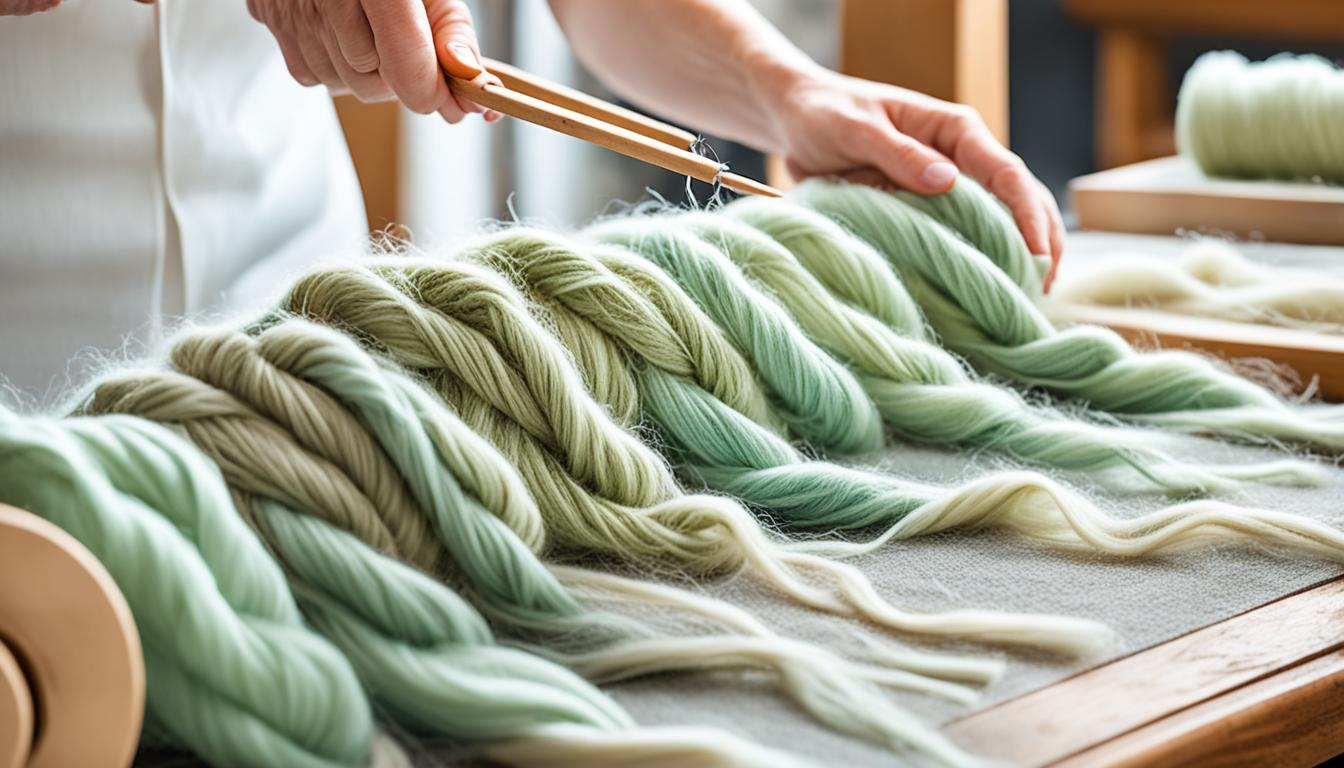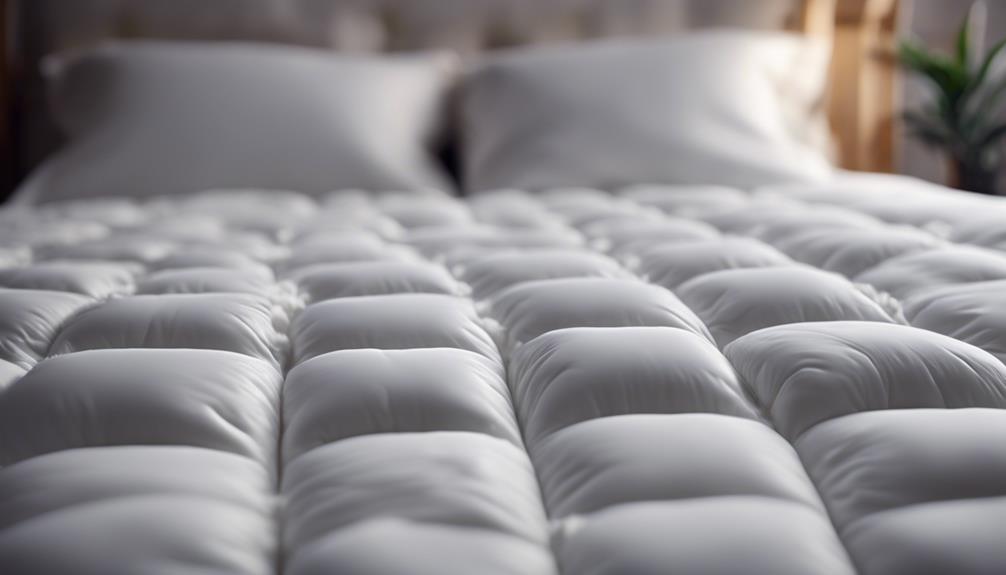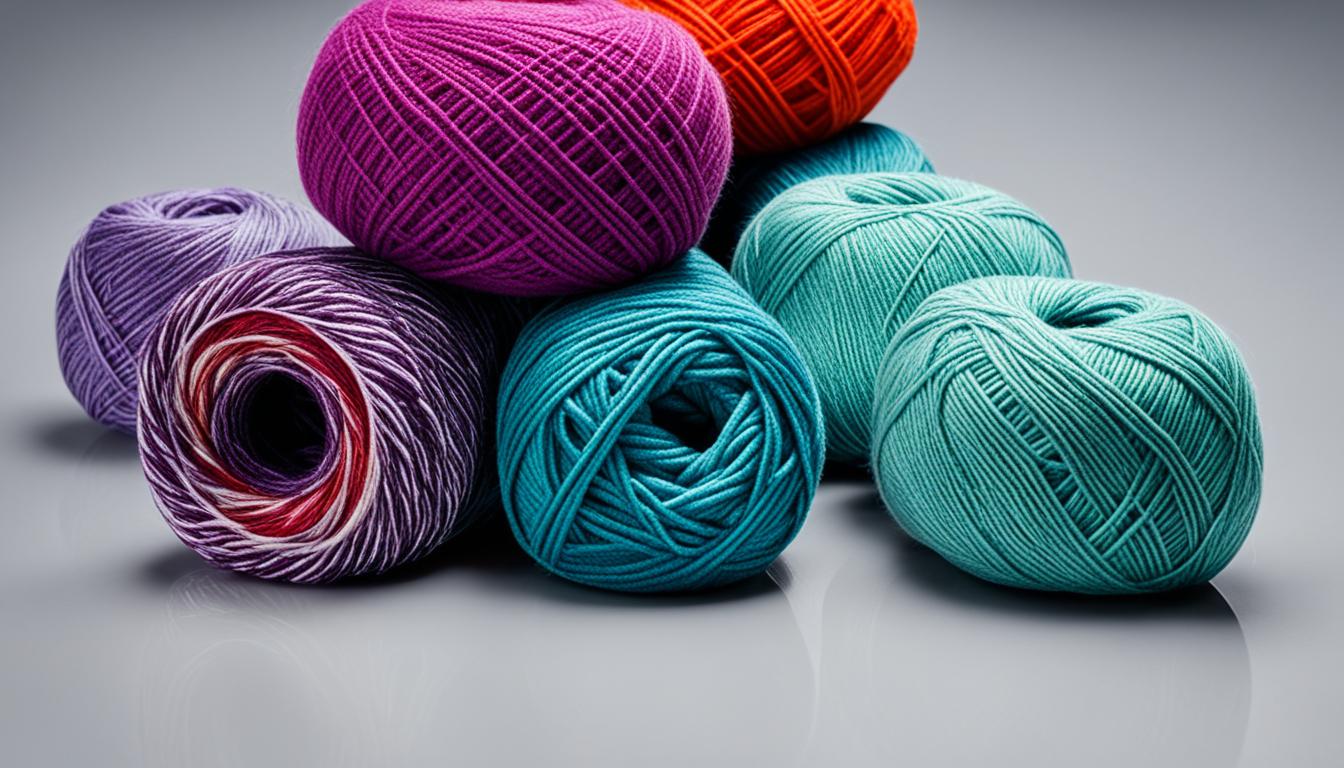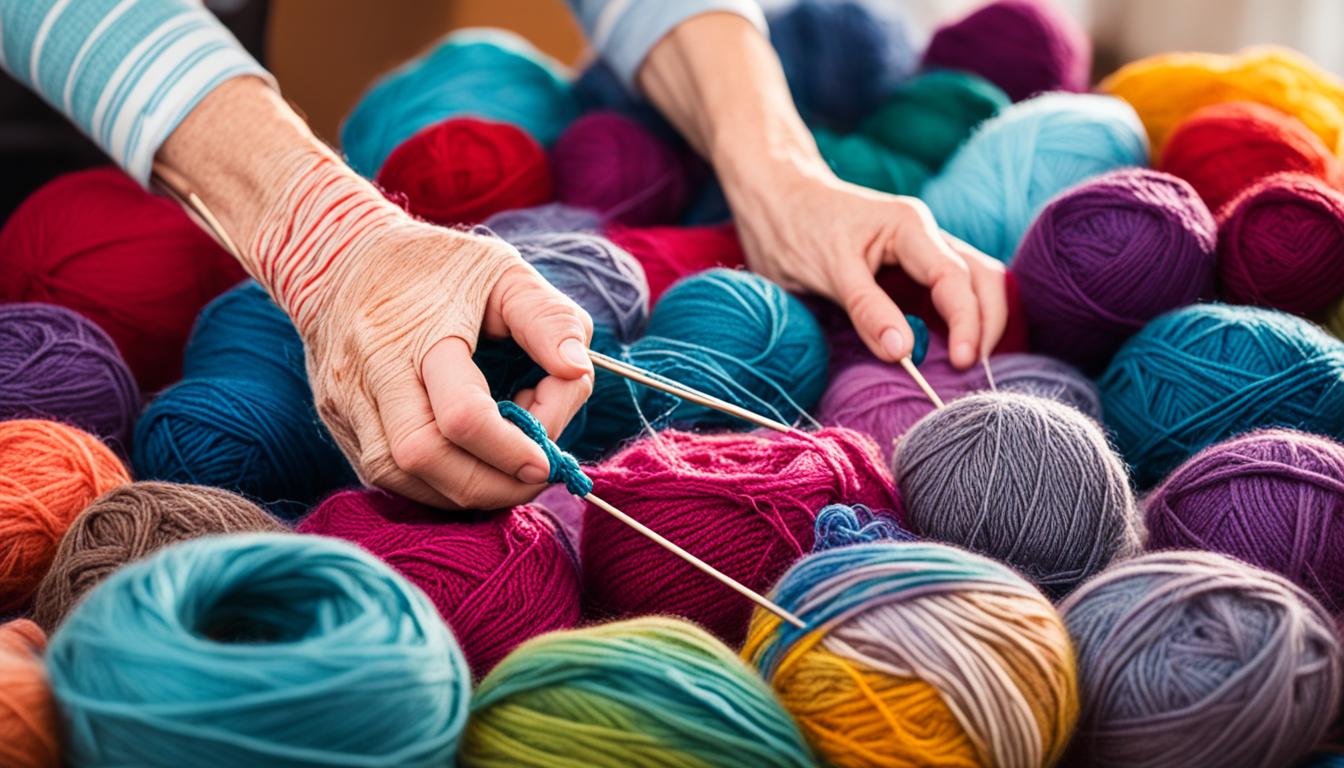Have you ever thought about how regular fibers can be turned into gorgeous, textured yarns? It’s time to discover the mysteries of core spinning! This special method enables you to make creative and expressive yarns that are brimming with charm and individuality.
Core spinning involves wrapping fibers around a core thread, resulting in a yarn with a distinctive texture. But how does it work, and what materials are best for core spinning? Let’s dive into the fascinating world of yarn spinning and discover the endless possibilities.
Key Takeaways:
- Core spinning is a method used to create wild and textured yarns.
- Choose a strong core thread to handle tension and twist.
- Spinning wheels with larger orifices and slow pulleys are ideal for core spinning.
- Experiment with different fibers and embellishments to create unique textures.
- Core spinning offers endless possibilities for handmade yarn with wild texture.
Choosing the Right Core Thread
When it comes to core spinning, one of the key factors to consider is choosing the right core thread. The core thread plays a crucial role in the spinning process as it is responsible for transferring the twist in the yarn. This means that the core thread experiences a significant amount of stress, especially when creating heavily textured yarns.
To ensure that your core thread can handle the tension and twist without breaking, it is recommended to use strong core threads such as crochet cotton, loop mohair, or brushed mohair. These materials have proven to be reliable choices for core spinning due to their durability and flexibility.
Some spinners follow a specific technique of adding the twist in one direction to the core thread and then core spinning in the opposite direction to balance the twist. However, it is important to note that achieving a perfectly balanced core thread is not necessary when core spinning. With practice and experience, the core-spun yarns will naturally become more balanced.
By selecting the right core thread and understanding the spinning techniques involved, you can create beautiful and textured core-spun yarns that showcase the uniqueness of core spinning.
Here is a table comparing different core threads for core spinning:
| Core Thread | Strength | Flexibility |
|---|---|---|
| Crochet Cotton | High | Medium |
| Loop Mohair | Medium | High |
| Brushed Mohair | Medium | Medium |
Wheel Adjustments for Core Spinning
Core spinning, a technique used to create unique and textured yarns, can be done on either a spinning wheel or a spindle. However, using a spinning wheel is often more convenient, especially when aiming to produce smoother and finer core-spun yarns. Modern spinning wheels are designed to handle larger-gauge or textured yarns, making them ideal for core spinning.
When selecting a spinning wheel for core spinning, look for key features that facilitate the process. Wheels with a larger orifice provide ample space for the core thread and wrapping fibers to pass through smoothly. Additionally, ensure that the hooks or pegs on the wheel won’t snag the fibers, as this can lead to issues during spinning.
Another important consideration is the wheel’s pulley system. Opt for spinning wheels with slow pulleys, as they allow for better control over the spinning process, especially for beginners. It is recommended to use the slowest ratio on the spinning wheel, preferably a ratio of 6:1 or lower, to prevent excess twist in the core thread.
As spinners gain more experience and become comfortable with core spinning, they may find that slightly higher speeds work better for their specific technique and desired yarn outcome.
By making the necessary wheel adjustments for core spinning, spinners can enjoy a smoother and more enjoyable spinning experience while creating beautiful core-spun yarns.
Key Wheel Features for Core Spinning
| Wheel Feature | Importance |
|---|---|
| Larger Orifice | Allows for smooth passage of core thread and wrapping fibers. |
| Non-Snagging Hooks/Pegs | Prevents fibers from getting caught or damaged during the spinning process. |
| Slow Pulleys | Offers better control over the spinning process. |
| Low Ratio (6:1 or lower) | Prevents excess twist in the core thread. |
With these wheel adjustments in mind, spinners can fully unlock the potential of core spinning and create stunning core-spun yarns.
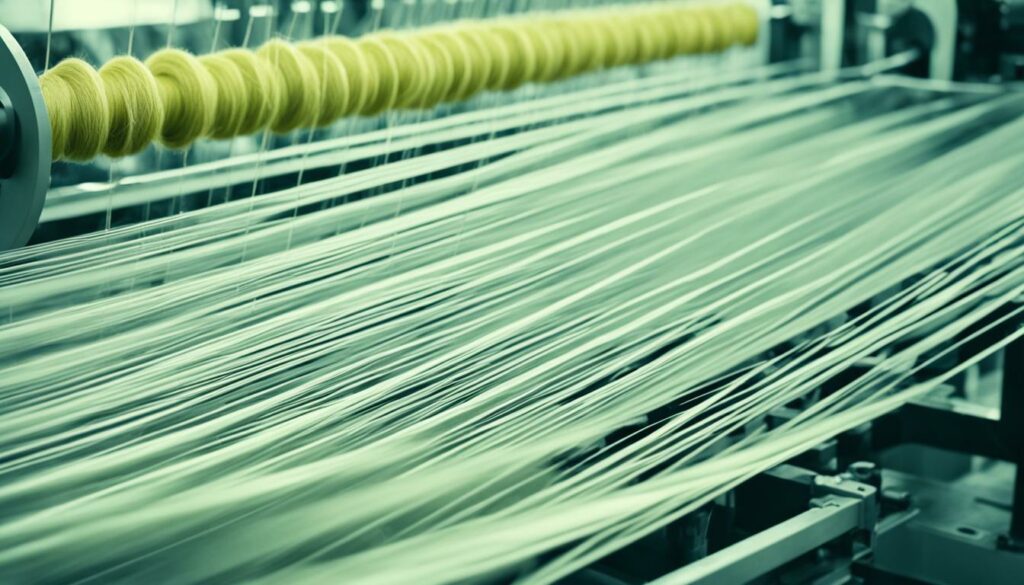
Types of Spinning Tension
When it comes to spinning tension, there are two types of spinners: “givers” and “takers”.
Givers prefer to spin a length of yarn and “give” it to the wheel, feeding the bobbin with long lengths of yarn. Takers, on the other hand, like to feel the wheel pull the yarn into the orifice while spinning, continually feeding yarn into the bobbin.
“Givers” and “takers” have different approaches to the take-up tension in their spinning process.
For core spinning, givers may need to increase tension to accommodate bulkier yarns. This ensures that the yarn is pulled through the orifice at a steady pace, allowing them to create the desired texture in the core-spun yarn.
On the other hand, takers may need to decrease tension to allow more time for wrapping the fiber around the core. This allows them to have better control over the wrapping process, resulting in a more even distribution of the fiber around the core thread.
It’s important to find the right balance of tension that works for you and your spinning technique. The tension should gently pull the yarn through the orifice, neither too loose nor too tight, at a speed that allows you to work comfortably and create the desired yarn characteristics.
Experiment with different levels of tension to find what works best for you. Remember to adjust the tension based on the thickness and texture of the yarn you’re creating.

| Givers | Takers |
|---|---|
| Prefer to spin a length of yarn and “give” it to the wheel | Like to feel the wheel pull the yarn into the orifice while spinning |
| Feed the bobbin with long lengths of yarn | Continually feed yarn into the bobbin |
| May need to increase tension for core spinning bulky yarns | May need to decrease tension for better control over wrapping |
Tips for Fine-Tuning Wild Texture
Core spinning is a versatile technique that allows you to create a wide range of textures and structures in your handspun yarn. If you’re looking to add some truly wild texture to your yarn, here are some tips to help you fine-tune your core spinning:
Create Sculptural Wires
If you want to add unique forms and shapes to your yarn, consider using wire as your core thread. Beading wire and floral wire are excellent choices for creating sculptural textures in your yarn. The malleability of the wire allows you to shape it in various ways, resulting in stunning and unconventional yarn designs.
Add Elastic for Ruffles
When you want to create ruffles and textured elements in your scarves or cowls, using an elastic core thread is a great option. The elasticity of the thread allows your finished piece to stretch and retain its shape, giving it a playful and dynamic look.
Enhance with Surface Thread Wraps
To secure wild textures, such as locks, and add visual appeal to your core-spun yarn, consider adding a surface thread wrap. You can use different types of threads for the wrap, such as contrasting colors or textured threads, to achieve the desired effect. The surface thread wrap not only adds dimension to your yarn but also helps hold the wild texture in place.
“Core spinning offers endless possibilities for creating unique textures and structures in your handspun yarn.”
With these tips, you can take your core spinning to the next level and create yarns with truly wild and exciting textures. Don’t be afraid to experiment and push the boundaries of traditional spinning techniques. Embrace the freedom core spinning provides and let your creativity soar.

| Embellishments | Description |
|---|---|
| Sculptural Wires | Creates unique forms and shapes in the yarn using wire as the core thread. |
| Elastic | Enhances ruffles and textured elements in scarves and cowls. |
| Surface Thread Wraps | Adds visual appeal and secures wild texture in the core-spun yarn. |
Troubleshooting Core Spinning Issues
Core spinning is a fascinating technique for creating unique and textured yarns. However, like any skill, it comes with its challenges. In this section, we will explore common problems encountered during core spinning and provide you with solutions to overcome them.
1. Too Much Twist
If you find that your core-spun yarn has excessive twist, which can result in a tightly spun and hard-to-work yarn, there are a few adjustments you can make. Firstly, try using the slowest ratio on your spinning wheel and treadling slower. This will help reduce the amount of twist being added to your yarn. Additionally, you can experiment with different drafting techniques to control the amount of twist transferred to the core, such as long draw or short forward draw.
2. Too Little Twist
On the other hand, if you’re experiencing a lack of twist in your core-spun yarn, resulting in loose fibers that are prone to unraveling, adjusting the wheel to a faster ratio can help. Increasing the speed of your wheel will add more twist to the yarn as it forms. Remember to practice slowly at first and gradually increase your speed until you achieve the desired twist in your yarn.
3. Take-Up Problems
Sometimes, you may encounter issues with the take-up of the yarn onto your bobbin. If your yarn is not winding onto the bobbin smoothly or is not being taken up at all, it’s crucial to address this problem. One possible solution is to add more tension to the yarn by adjusting the tensioning mechanism on your spinning wheel. Another possible culprit could be the flyer guides. Check for any obstructions or buildup that may be impeding the smooth flow of yarn and clean them if necessary.
4. Orifice Problems
If you specialize in creating bulky core-spun yarns using thick and textured fibers, you may encounter orifice problems. A narrow orifice may not be able to accommodate these bulkier textures, leading to frustration and difficulties in spinning. In such cases, consider using a spinning wheel with a larger orifice to accommodate the size of the fibers you’re working with. This will allow for smoother and more effortless spinning of your desired yarn.
5. Spinning Slippery Locks
Working with slippery locks, such as mohair or silk, can present its own set of challenges due to their smooth and lustrous nature. Spinning these locks while they are slightly damp can provide better control and grip, making the process easier. The moisture adds some friction, allowing the fibers to hold onto the core thread more effectively. Remember not to oversaturate the locks, as too much moisture can impact the overall quality of your spun yarn.
By troubleshooting these core spinning issues, you can enhance your spinning experience and create beautiful, textured yarns with confidence. Keep practicing and experimenting, and soon you’ll be able to overcome any challenges that come your way!
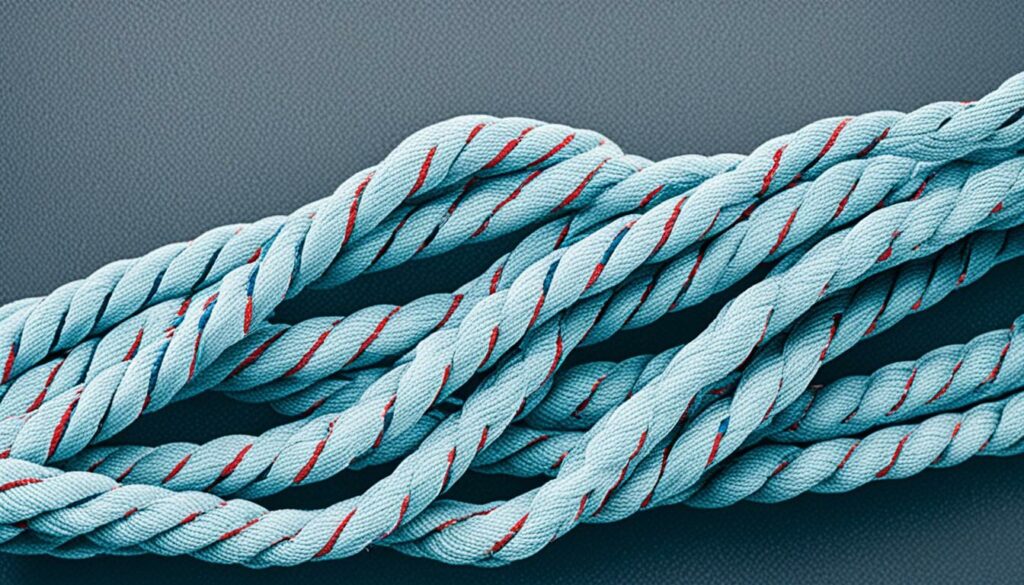
Core Spinning Art Batts
Art batts are a versatile and exciting option for core spinning, allowing you to create unique and textured yarns that are bursting with personality. These prepared fiber blends are specifically designed for core spinning and offer endless possibilities for creativity. With art batts, you can explore different colors, fibers, and textures to achieve the exact yarn you envision.
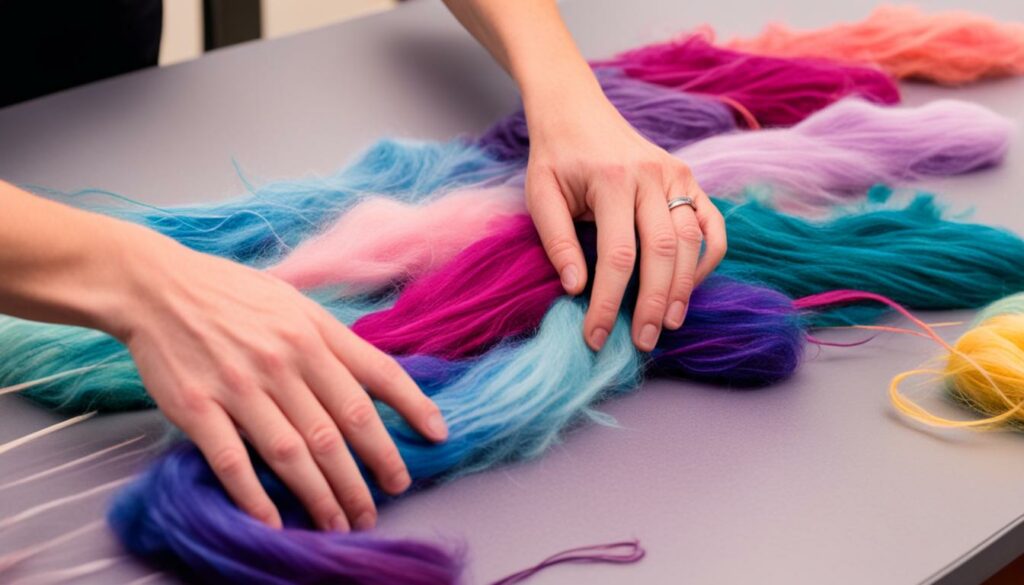
When core spinning art batts, start by inserting the core thread into a bobbin leader with a loop. This loop will help secure the fiber onto the core thread. With the fluffy end of the predrafted fiber held at a 90-degree angle to the core, begin treadling slowly. As you treadle, allow the fiber to catch onto the thread and wrap around it, creating a beautiful and textured yarn. The thickness of the resulting yarn can be controlled by adjusting the amount of fiber wrapped around the core.
Once you have finished core spinning your art batts, you have a few options for finishing. You can wash the yarn to set the twist, or you can choose to steam it. This will help the yarn to relax and solidify, ensuring that all the fibers are secured in place. The finished yarn will have a delightful texture and a unique appearance that is sure to impress.
Harness the potential of art batts in your core spinning journey and unlock a whole new world of creativity. These fiber blends are specifically crafted to inspire and empower you to create yarns that are as individual as you are.
Core Spinning Locks
Locks, which are individual sections of fiber, can be core spun to create textured yarns. The locks are held at a 90-degree angle to the core thread and begin wrapping around it as you treadle slowly. Use your index finger to smooth, support, and control the fiber as it wraps. Mohair core thread works well for spinning wool locks because the fuzzy texture of the mohair allows the locks to grab onto it easily. The amount of picking done on the locks will determine the level of texture in the finished yarn.
For a complete guide on how to core spin locks, refer to the table below:
| Step | Action |
|---|---|
| 1 | Prepare your materials: locks, core thread (such as mohair), spinning wheel or spindle. |
| 2 | Hold the lock at a 90-degree angle to the core thread. |
| 3 | Begin treadling slowly while allowing the lock to wrap around the core thread. |
| 4 | Use your index finger to smooth, support, and control the fiber as it wraps. |
| 5 | Continue treadling and wrapping until the desired amount of locks is included in the yarn. |
| 6 | Finish the yarn by plying or securing the ends. |
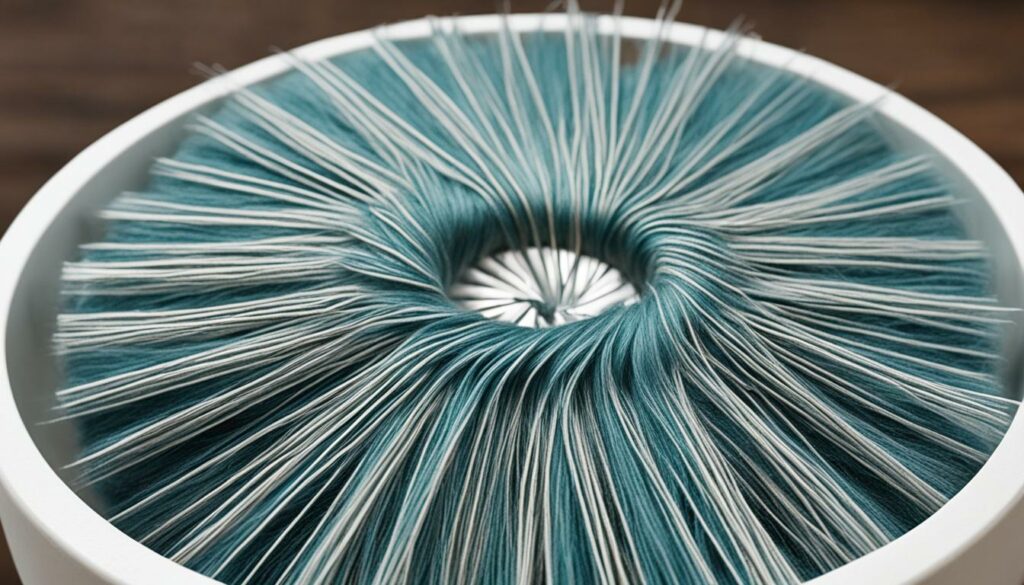
With this technique, you can create yarns with unique texture and visual interest by incorporating locks into your core-spun yarn. Experiment with different breeds and colors of locks to add depth and character to your handspun creations.
Spinning Fine Yarn on Spindles
If you’re a beginner looking to try your hand at spinning fine yarn, spindles are a cost-effective option that allows you to explore this craft. When spinning fine yarn, the thickness of the drafting triangle plays a crucial role in achieving the desired fineness. A thinner drafting triangle enables finer spinning and allows for greater control over the yarn.
To determine the limits and length of the drafting triangle, it’s important to have an understanding of the staple length of the fiber you’re working with. This knowledge helps you adjust your spinning technique accordingly, ensuring optimal results. When aiming for a fine yarn, well-prepared fiber such as roving or top is recommended.
There are different fiber preparations that impact the texture of the yarn. If you’re looking to create a puffy yarn, woolen preparations like roving or rolags are suitable choices. These preparations result in a yarn with added loft and puffiness. On the other hand, if you prefer a smoother yarn, top or combing the fiber aligns the individual fibers, resulting in a more even and silky yarn.
The weight of the fiber can also affect the spinning process when using a spindle. To optimize your spinning experience, it’s often suggested to work with shorter lengths of fiber. This allows for better control and reduces strain during the spinning process, ensuring a more enjoyable and fulfilling experience.
| Advantages of Spinning Fine Yarn on Spindles | Considerations |
|---|---|
| Cost-effective option for beginners | Requires practice to achieve consistent fineness |
| Portable and easy to transport | May have limitations in producing very fine yarns |
| Allows for greater control over drafting and twist | Requires more time and effort compared to spinning wheels |
| Opportunity to develop a deeper understanding of the spinning process | May require additional tools and accessories |
Spindles offer a unique and hands-on approach to spinning fine yarn. They provide a gateway for beginners to delve into the world of spinning and explore the intricacies of fiber crimp and drafting. With practice and perseverance, you’ll soon master the art of spinning fine yarn on a spindle, creating beautiful, handmade yarn that reflects your creativity and dedication.
Plying Fine Yarn
Once you have finely spun singles yarn, it’s time to ply it using various techniques to add depth and texture to your yarn creations. Two-ply yarn and Navajo plying are two common methods that yield beautiful results. Let’s explore each technique in detail.
Two-Ply Yarn
Two-ply yarn is created by twisting two independently spun bobbins together in the opposite direction from which they were spun. This process not only strengthens the yarn but also creates mingling colors and visual interest. To achieve a balanced two-ply yarn, make sure to maintain consistent tension while plying.
Tip: Experimenting with different color combinations in your two-ply yarn can create stunning effects in your finished projects.
Navajo Plying
Navajo plying, also known as chain plying, is a technique often used when there is only one bobbin or when wishing to preserve long color changes. This method involves creating giant crocheted chains from one strand of spun yarn and then plying it to create a thicker yarn. Navajo plying allows for greater control over color changes and results in a yarn with distinct striping or color blocking.
Pro tip: You can use Navajo plying to create stunning gradient yarns by carefully selecting and transitioning between different colors in your chain.
Both two-ply yarn and Navajo plying offer endless possibilities for exploring creativity and designing unique yarns. Whether you prefer the mingling colors of two-ply or the controlled color changes of Navajo plying, these techniques will elevate your yarn spinning to the next level of artistry.
Now that you have learned about plying fine yarn, it’s time to experiment with these techniques and see what beautiful creations you can produce!

| Technique | Description |
|---|---|
| Two-Ply Yarn | Twisting two independently spun bobbins together in the opposite direction to create a balanced yarn with mingling colors. |
| Navajo Plying | Creating giant crocheted chains from one strand of yarn and then plying it to create a thicker yarn with controlled color changes. |
Conclusion
Congratulations on completing this guide to spinning yarn! By mastering spinning techniques, you have unlocked the ability to create beautiful and unique handmade yarn. Whether you use a spinning wheel or a spindle, the possibilities are endless.
With each spin, you will become more proficient, and your confidence will grow. Remember to experiment with different fibers, textures, and techniques to truly make your yarn one-of-a-kind. As you continue on your spinning journey, don’t be afraid to push your boundaries and explore new ideas.
So, what are you waiting for? Grab your wheel or spindle and let your creativity soar. Get lost in the meditative rhythm of spinning, and watch as your handmade yarn takes shape. Whether you spin for relaxation, creative expression, or to create art, spinning yarn is a craft that will bring you joy for years to come.
